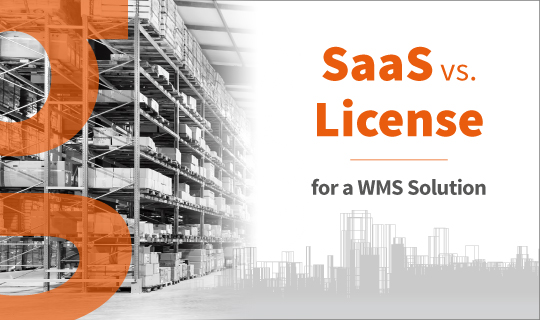
E-Invoicing and Its Geopolitical Stakes
France’s electronic invoicing reform relies on a Y-architecture, where Partner Dematerialization Providers (PDPs) play a central role in issuing and…
Generix Announces New AI-Powered Resource Management System (RMS) to Intelligently Optimize All Warehouse Resources Read the press release

With so many options on the market and a variety of implementation models, it can be daunting to select the WMS best adapted to your operation. In what follows, we take a closer look at two deployment models, SaaS and license acquisition (on-premises), and discuss some of the reasons why most distribution and manufacturing operations should favor the former over the latter.
When purchasing a WMS through a license model, licensees are in fact buying a product that they then own. Typically, companies obtain the rights (albeit, often limited) to the actual software and its source code through a single, high expenditure. They must then implement the WMS on privately owned servers – either on-premises or external. Meanwhile, by subscribing to a SaaS WMS, operators gain access to the software and its functionalities, but do not own the product itself. The WMS remains hosted on the service provider’s servers, which operators access via the internet. Instead of one initial expenditure, as with the license model, companies pay monthly or annual fees to use the WMS and benefit from the provider’s maintenance and support services.
One key difference between the two models, then, is that a license buys operators a product, the WMS itself, whereas a subscription to a SaaS WMS provides access to the software and to a range of adapted services. Companies that decide to purchase a license must therefore purchase these services on top of the WMS itself. Given the high initial expenditure required to purchase a license, this can have a serious impact on a company’s financial agility.
Some might argue that, over time, subscription fees will amount to a larger TCO than the license model. This is not the case. Hypothetically speaking, a SaaS WMS solution that runs on local infrastructure could possibly be more expensive than a purchased WMS. However, since users typically turn to SaaS solutions precisely to avoid on-premises deployments, the TCO of a SaaS WMS will always be significantly cheaper. This is true, for instance, of Generix’s SOLOCHAIN WMS.
When determining the TOC of a WMS license, companies must consider the costs of acquiring the technology and infrastructure needed to run it. On top of the hardware, they must also think of the ongoing maintenance costs to ensure that the solution always runs optimally. And because the WMS is implemented on private servers, TOC must also include the costs of a dedicated inhouse IT team to develop, integrate, support, and improve the solution.
A SaaS WMS is hosted on the service provider’s servers, which spares companies from such expenses. With SaaS, there’s no need for an expensive infrastructure upgrade or a specialized local IT team. The subscription fees cover the use of the WMS itself as well as maintenance and support services from the provider.
Since we’re on the topic of maintenance services, let’s look at what companies can expect when comes time to develop and update their WMS.
Because SaaS subscribers are paying for a service, not a product, they do not have to wait or spend more of their precious capital to benefit from the software’s newest version and functionalities. The service provider in fact has an incentive to keep developing its product: the better the service, the more likely they are to retain and grow their customer base. And since the solution is hosted on the provider’s servers, the implementation and integration of new modules is typically a painless operation – at least from the subscriber’s point of view!
This is not the case under the license model. In that case, the developer’s main source of revenue comes from selling new versions of the WMS. It, therefore, makes commercial sense for them to withhold new functionalities until they can market a new, complete version of their WMS. For licensees, this means that they are at the developer’s mercy when it comes to scaling their system. It also means further implementation and integration fees, which adds to the solution’s TOC.
There’s yet another, somewhat collateral advantage to the SaaS model. With SaaS, a relationship naturally builds between subscribers and the service provider that enables a rich feedback loop. Thanks to constant retroaction from users, developers can scale the solution with modules and capabilities that are truly adapted to their client’s real requirements. This is far less likely to happen with the license model where the relationship with the vendor often ends once the terms of the contract have been met. This last point might explain part of the success Generix has had with its SOLOCHAIN WMS/MES solution in SaaS mode. By developing their system in collaboration with users and external partners, the engineers and developers at Generix have designed the only full featured WMS/MES solution featured in Gartner’s Magic Quadrant.
Prospective buyers sometimes worry that a SaaS WMS is more at risk of becoming unavailable, if something goes wrong, than a product that is implemented on local servers. That worry is unfounded, as a SaaS solution is often the safest option between the two models when it comes to availability.
Under a subscription model, service providers commit to an SLA where they guarantee the system’s uptime. Generix, for example, guarantees that its WMS will be up and running at its clients’ operation 99.9% of the time. If anything were to go amiss, the provider is entirely responsible for providing a solution and has every possible incentive to do so as fast as possible. On the other hand, when something goes wrong with an on-premises or privately owned WMS, companies must scramble to find the resources to fix the issue. If their IT team is unable to solve the problem, a WMS malfunction can severely slow down, if not completely halt operations for hours as they wait for external support. And that support, of course, costs money.
When Microsoft saw that Google’s Workspace, which is only available as SaaS, was gaining on its Office suite, the developer moved its solution to the web and created Office 365. Since then, Microsoft has been able to reverse the tide and solidify its share of the market. SaaS solutions are not a fad. As we have seen, TCO, scalability, and the system’s availability make the subscription model a very attractive solution. This is especially true to SMBs and companies with limited access to capital. A SaaS WMS like SOLOCHAIN is an affordable technology solution that offers everything you need to transform operations in your warehouse.
Generix Group North America provides a series of solutions within our Supply Chain Hub product suite to create efficiencies across an entire supply chain. Our solutions are in use around the world and our experience is second-to-none. We invite you to contact us to learn more.

France’s electronic invoicing reform relies on a Y-architecture, where Partner Dematerialization Providers (PDPs) play a central role in issuing and…

The B2B mandate in Germany, set to take effect on January 1, 2025, marks a crucial step in the European…

Following the October 15 announcement regarding the abandonment of the PPF development, the DGFIP and its partner AIFE are ramping…

Work with our team to build your ideal supply chain software stack and tailor it to your unique business needs.